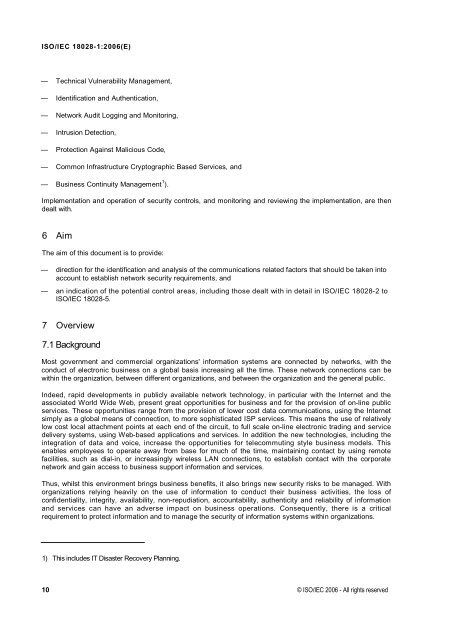INTERNATIONAL ISO/IEC STANDARD 18028-1
INTERNATIONAL ISO/IEC STANDARD 18028-1
INTERNATIONAL ISO/IEC STANDARD 18028-1
- No tags were found...
Create successful ePaper yourself
Turn your PDF publications into a flip-book with our unique Google optimized e-Paper software.
<strong>ISO</strong>/<strong>IEC</strong> <strong>18028</strong>-1:2006(E)— Technical Vulnerability Management,— Identification and Authentication,— Network Audit Logging and Monitoring,— Intrusion Detection,— Protection Against Malicious Code,— Common Infrastructure Cryptographic Based Services, and— Business Continuity Management 1 ).Implementation and operation of security controls, and monitoring and reviewing the implementation, are thendealt with.6 AimThe aim of this document is to provide:— direction for the identification and analysis of the communications related factors that should be taken intoaccount to establish network security requirements, and— an indication of the potential control areas, including those dealt with in detail in <strong>ISO</strong>/<strong>IEC</strong> <strong>18028</strong>-2 to<strong>ISO</strong>/<strong>IEC</strong> <strong>18028</strong>-5.7 Overview7.1 BackgroundMost government and commercial organizations' information systems are connected by networks, with theconduct of electronic business on a global basis increasing all the time. These network connections can bewithin the organization, between different organizations, and between the organization and the general public.Indeed, rapid developments in publicly available network technology, in particular with the Internet and theassociated World Wide Web, present great opportunities for business and for the provision of on-line publicservices. These opportunities range from the provision of lower cost data communications, using the Internetsimply as a global means of connection, to more sophisticated ISP services. This means the use of relativelylow cost local attachment points at each end of the circuit, to full scale on-line electronic trading and servicedelivery systems, using Web-based applications and services. In addition the new technologies, including theintegration of data and voice, increase the opportunities for telecommuting style business models. Thisenables employees to operate away from base for much of the time, maintaining contact by using remotefacilities, such as dial-in, or increasingly wireless LAN connections, to establish contact with the corporatenetwork and gain access to business support information and services.Thus, whilst this environment brings business benefits, it also brings new security risks to be managed. Withorganizations relying heavily on the use of information to conduct their business activities, the loss ofconfidentiality, integrity, availability, non-repudiation, accountability, authenticity and reliability of informationand services can have an adverse impact on business operations. Consequently, there is a criticalrequirement to protect information and to manage the security of information systems within organizations.1) This includes IT Disaster Recovery Planning.10 © <strong>ISO</strong>/<strong>IEC</strong> 2006 - All rights reserved
















